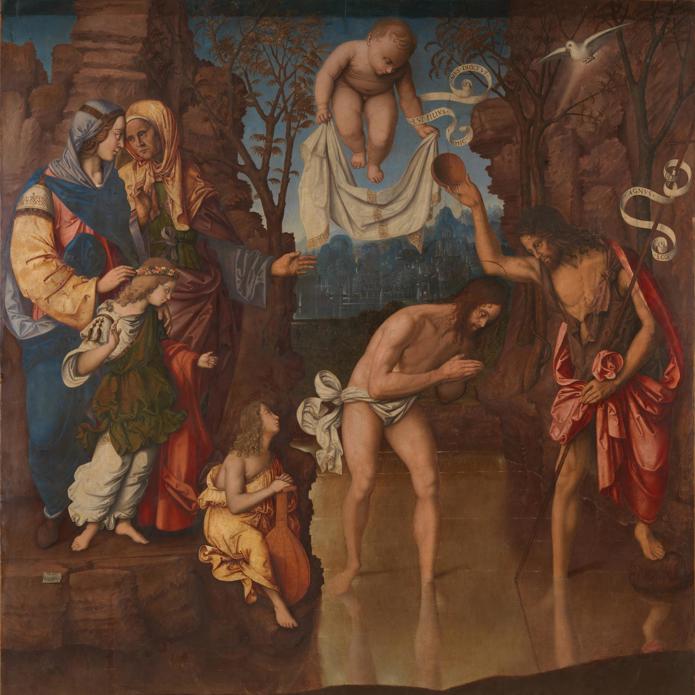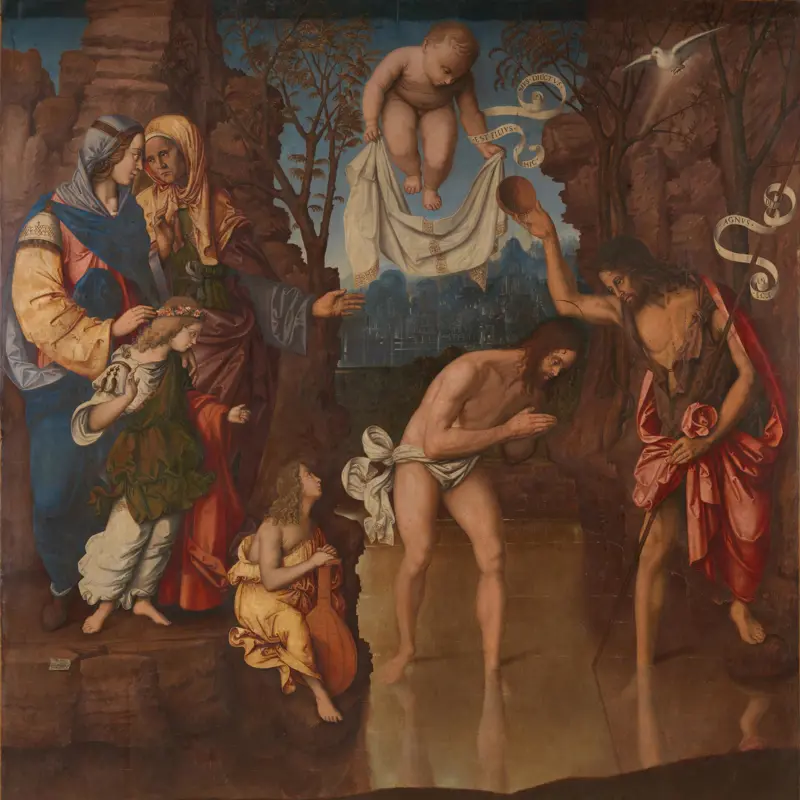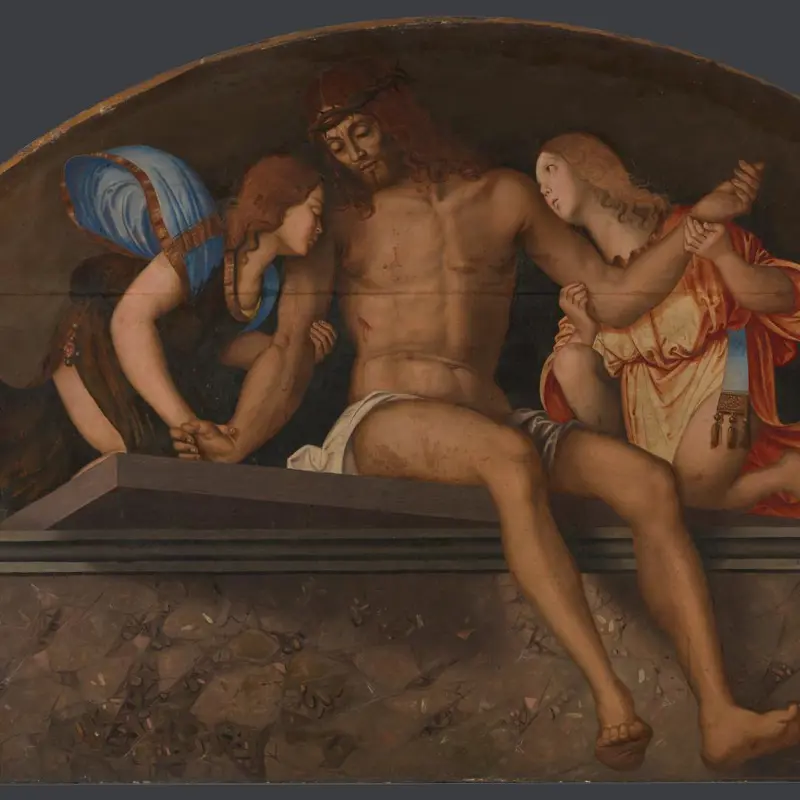Francesco Zaganelli, 'The Dead Christ with Angels', 1514
About the work
Overview
This is the lunette, or upper panel, of an altarpiece for the chapel of the Visitation in S. Andrea in Vineis, Faenza. The dead Christ sits on the lid of his stone tomb supported by two angels. The lid is placed obliquely so that it appears to project into our space, as do Christ’s legs. Zaganelli has painted Christ’s body as if in our space to emphasise that it is the origin of the Host (consecrated bread) that would be placed on the altar below the painting during the sacrament of the Eucharist.
The crucified Christ rising from the tomb in the lunette shows the destiny accepted by Christ at his baptism, which is depicted in the main panel of the altarpiece. Saint John the Baptist holds a reed cross which bears a scroll inscribed ‘Ecce Agnus Dei’ (‘Behold the Lamb of God’). This refers to Christ, who will be sacrificed like a lamb for the salvation of humanity.
Key facts
Details
- Full title
- The Dead Christ with Angels
- Artist
- Francesco Zaganelli
- Artist dates
- Active 1499, died 1532
- Part of the series
- The Laderchi Altarpiece from San Domenico, Faenza
- Date made
- 1514
- Medium and support
- Oil on wood (probably poplar)
- Dimensions
- 98.1 × 202.5 cm
- Acquisition credit
- Bought, 1924
- Inventory number
- NG3892.2
- Location
- Not on display
- Collection
- Main Collection
- Frame
- 19th-century Italian Frame with Later Additions
Provenance
Additional information
Text extracted from the ‘Provenance’ section of the catalogue entry in Giorgia Mancini and Nicholas Penny, ‘National Gallery Catalogues: The Sixteenth Century Italian Paintings’, vol. 3, ‘Bologna and Ferrara’, London 2016; for further information, see the full catalogue entry.
Bibliography
-
1962Gould, Cecil, National Gallery Catalogues: The Sixteenth Century Italian Schools (excluding the Venetian), London 1962
-
1987Gould, Cecil, National Gallery Catalogues: The Sixteenth Century Italian Schools, London 1987
-
2001
C. Baker and T. Henry, The National Gallery: Complete Illustrated Catalogue, London 2001
-
2016Mancini, Giorgia, and Nicholas Penny, National Gallery Catalogues: The Sixteenth Century Italian Paintings, 3, Bologna and Ferrara, London 2016
Frame
This is a nineteenth-century lunette frame, made after a seventeenth-century Italian style. The water-gilded frame also has modern additions. An acanthus-leaf and lamb’s-tongue motif adorns the back edge. The moulding features a torus-shaped frieze decorated with carved cabochons (egg-and-nest), each inset with flower heads. A lamb’s-tongue pattern embellishes the sight edge.
The modern additions to the nineteenth-century arched frame were made at the Gallery in 2014.
In 1924, when the Gallery acquired Zaganelli’s The Dead Christ with Angels, the lunette was set in a rectangular architectural gilded moulding, with spandrels to complement its arched shape.
About this record
If you know more about this work or have spotted an error, please contact us. Please note that exhibition histories are listed from 2009 onwards. Bibliographies may not be complete; more comprehensive information is available in the National Gallery Library.
Images
About the series: The Laderchi Altarpiece from San Domenico, Faenza
Overview
These two panel paintings formed the altarpiece for the Laderchi chapel in S. Andrea in Vineis, Faenza (the church was rebuilt in the eighteenth century and rededicated as S. Domenico). The main panel represents two episodes from the New Testament: the Visitation of the Virgin Mary to her cousin Saint Elizabeth, who was pregnant with Saint John the Baptist; and the baptism of Christ in the river Jordan by Saint John the Baptist. The lunette, or upper panel, shows the dead Christ sitting on his open tomb, supported by two angels.
On 9 April 1504, Giacomo di Francesco Laderchi dictated a will in which he ordained that after his death his brothers should spend 100 lire in adorning the chapel of the Visitation, which he had paid to have built in 1489. Given the prominence of John the Baptist in this altarpiece, his brother Giovanni Battista was probably most closely involved in the commission.



